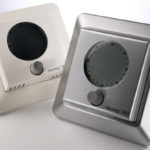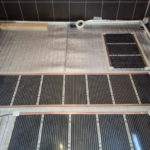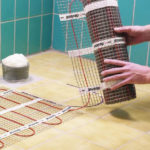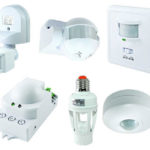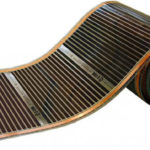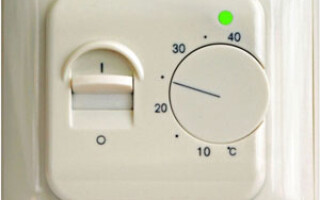Underfloor heating is an excellent solution for a comfortable stay in the bathroom or any other room. Well-coordinated work of all units of the system guarantees durable and safe use of infrared heat-insulated floors. The thermostat is an indispensable device that automatically regulates the temperature of the floor surface.
Content
General principles for connecting thermostats to a warm floor
There are different types of thermostats: mechanical, electronically controlled, with a touch panel or with a conventional switch knob.Their connection principles are similar, despite external differences.

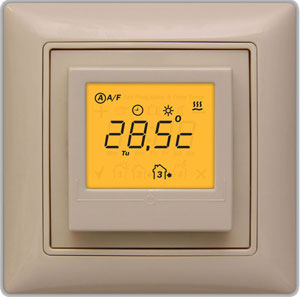
Choosing the optimal installation location for the thermostat
A dry wall, which is not affected by drafts and direct sunlight - the optimal installation location thermostat. Connecting to electricity will facilitate the outlet, if it is nearby. The installation height of the device depends on the desire and convenience of the consumer, usually 0.4 - 1.7 meters from the floor.
The controller is installed in two ways to choose from:
- built-in - a cavity for the supply cables is hollowed out in the wall and the thermostat housing, placed in the mounting box, is embedded in the prepared hole;
- Wall - wires and thermostat are located outside. In this case, the integrity of the wall at the point of attachment of the device is not violated.
REFERENCE! The sensor cable going to the thermostat from the underfloor heating in the first version is conveniently laid in a metal-plastic pipe, and not in corrugation. If the device fails, it can be easily replaced.
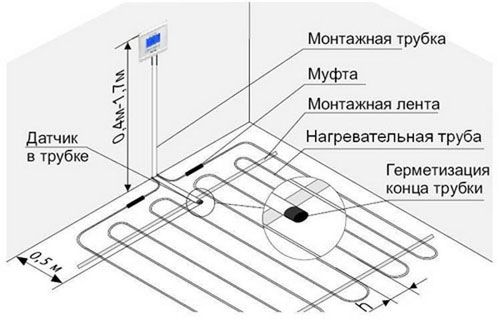
Wiring diagram for thermostat
The thermostat is made in the form of a square box with connectors. Manufacturers indicate the wiring diagram on the back cover of the device and it is not difficult to understand it, since the terminal blocks are numbered:
- No. 1, 2 - for power wires;
- Nos. 3, 4 - for wires coming from heating mats;
- №№ 6, 7 – temperature sensor.
The letter marking of the connectors means:
- L - phase (for white, black or brown wires);
- N is zero (Blue colour).
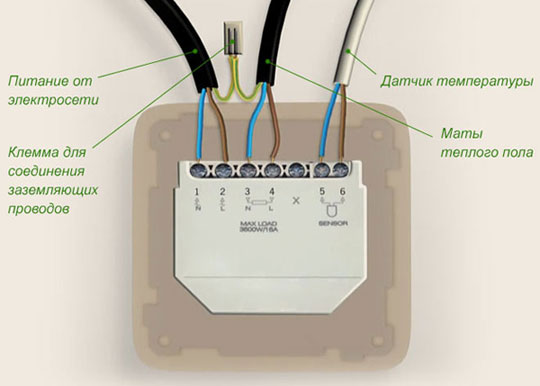
The procedure for connecting wires to the thermostat consists of three stages.
- mains cable connection:
- phase wire L is connected to connector 1;
- wire N, zero is connected to socket 2.
- heating cable connection:
- neutral wire N is inserted into terminal 3;
- to terminal 4 - phase L.
- the temperature sensor is connected without observing the polarity in connectors 6 and 7.
Setting the thermostat
Common models of thermostats are equipped with a software module that sets the required floor temperature for any time period. The touch screen allows you to carry out this procedure with a few clicks.
The "up" and "down" keys set the desired temperature in manual mode after turning on the device.
The auto adjustment settings will take some time.
Setting the date and time.
There is a “book” button on the panel, for 5 seconds it is necessary to hold it pressed simultaneously with the “up” arrow. A menu opens in which you can set both the hours and the days of the week (indicated by numbers from 1 to 7). The power button saves the selected option.
Adjustment of heating by days and hours
The settings menu is activated using the “book” icon, which you need to press for 5 seconds. In the main time slot settings, weekdays come first. Options are selected by pressing the "book", the time is selected with the "up" and "down" keys. The cycle of settings is repeated in the following sequence: day of the week - time - temperature. You can set up by dividing the day into 6 segments:
- climb;
- left the house;
- returned for lunch;
- left from dinner;
- returned in the evening;
- night mode.
Service menu settings
They are activated when the device is turned off by pressing the "on" and "book" buttons. Using the service menu, you can configure:
- Calibration of sensors;
- Switching sensors or their simultaneous activation;
- Temperature limitation;
- Temperature step adjustment (by default, the turn-on-off step of the floor is 1 degree);
- Minimum warm-up mode;
- Maximum heating;
- Reset.
Children's mode
The screen of the thermostat can be protected from accidental pressing by connecting a lock. Simultaneously pressing the up and down keys for 5 seconds provides reliable protection of the controller from unauthorized switching.
Faults
The reliability of thermostats depends on the quality of the components from which the devices are made.
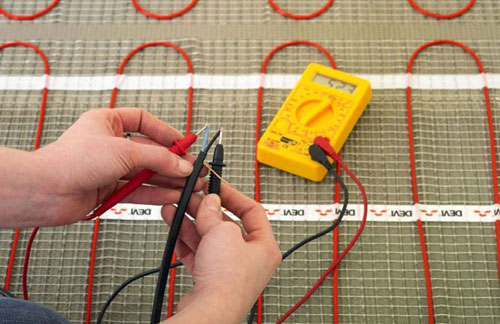
Typical malfunctions:
- Mechanical damage is a common failure for devices of a low price category. Inaccurate handling leads to the failure of buttons, wheels and front panels.
- An important component of the thermostat is a contact relay, the resource of which is limited by the number of on-off cycles. Over time, the part wears out and power is no longer supplied to the heating cable;
- Power surges in the mains are guaranteed to disable the electronic "stuffing" of the controller;
- Incorrect connection of the device can lead to a short circuit and damage to the device.
Connecting a warm floor without using a thermostat
It is theoretically possible to connect floors to electricity without using a thermostat, but this solution is unjustified for several reasons:
- Risk of system overheating - there is no control over changes in the temperature of the heating film, which heats up to the maximum operating temperature, which is at least 60 ° C.The floor covering, regardless of its type, becomes a heat accumulator and increases the temperature of the heating elements by an additional 10-15 degrees.
- Continuous operation at high temperatures shortens the life of the product and leads to its breakdown;
- The need for constant monitoring - to prevent the problems described above, the warm floor will have to be turned on and off manually, which does not ensure its comfortable operation;
- Increased power consumption - a constantly running system leads to additional loads in the power grid and unjustified power consumption;
- Discomfort in use - associated with the heating of the floor covering used. For example, tile has low thermal conductivity. Its surface can heat up to the maximum possible temperature indicators provided by the characteristics of the system;
- Overheating of the floor covering entails additional repair costs, since the elements of the laminate and parquet board dry out during use, linoleum fades and warps. Carpeting emits volatile toxic substances, tile adhesive is destroyed by temperature changes.
Connection of films among themselves at an infrared heat-insulated floor
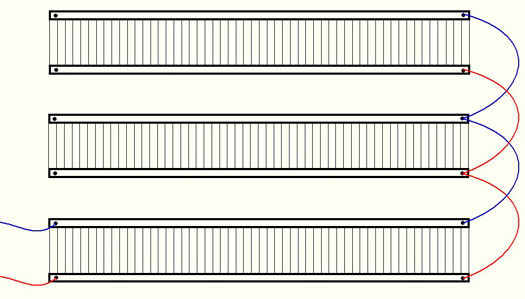
Laying an infrared film floor is a painstaking process, but does not require special skills.
IMPORTANT! It is necessary to carefully read the instructions: each manufacturer has its own requirements for cutting mats and installing the system, as well as recommendations for using the substrate and RCD - protective shutdown device.
The design of the infrared floor heating includes a film heater, which is produced in rolls and has an average thickness of up to 2 mm.Inside the film, between the copper strands, there are strips of carbon, which are heated by the electric current passing through them. On mats, manufacturers apply dotted lines indicating the cut line. Cutting must be done taking into account the furniture in the room: a warm floor is not laid under it.
The strips of film are placed on the floor so that they do not touch each other. Some manufacturers recommend laying mats with an overlap, maintaining a distance between adjacent tires of no more than 1 cm. They are fixed with double-sided tape, which must be removed after installation work.
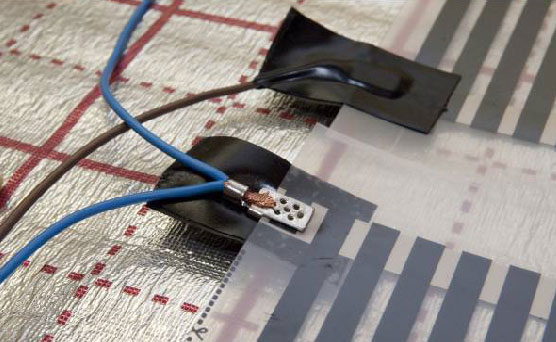
Operating procedure:
- Laying the substrate around the perimeter of the room - the use of metals in its reflective surface should be excluded;
- Distribution of mats, taking into account the geometry of the room, indented from the walls at a distance of 5-7 cm;
- Installation of power supply fasteners - these are special clips in the form of plates connected at an angle. One plate is inserted into the cavity under the lamination and superimposed on the copper core. The second, with the help of pliers, compresses it from the other side;
- Connecting wires - it is recommended to use two-color. The connection scheme is parallel, that is, the wires are located on one side. It is obligatory to check their tight fastening in the contact clamps and isolation with liquid rubber, which is included in the kit;
- Performing waterproofing of current-carrying parts, to which the terminal with wires will not be connected;
- Setting the thermostat sensor under the heating elements;
- Thermostat connection;
- Test connection of a warm floor with checking each element for heating.
Conclusion
The absence of a temperature sensor in the underfloor heating circuit leads to malfunctions in the use of heating elements and inevitable material costs. This device is an important constructive component in the floor heating system.
Similar articles:
